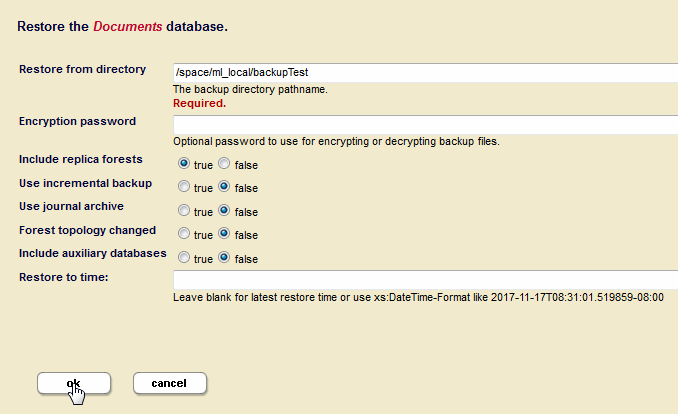Restoring a Database without Journal Archiving
This section describes how to restore a database if no journal archiving was enabled for the last backup.
Note
If your last backup enabled Journal Archiving, stop here and follow the procedure described in Restoring Databases with Journal Archiving.
To restore an entire database from a backup, follow these steps:
Note
You must have the Admin role to complete this procedure.
Log into the Admin Interface as a user with the
adminrole.Click the Databases link in the left menu of the Admin Interface.
Click the database name for the database you want to restore, either on the tree menu or on the summary page. This database should have the same configuration settings (index options, fragmentation, range indexes) as the one that was backed up.
Click the Backup/Restore tab. The Backup/Restore screen appears.
Enter the directory in which the back up exists in the Restore From Directory field.
If the backup was encrypted, enter the encryption password.
Note
If you enter a directory that contains multiple backups of the same database, the latest one is used. If you want to choose a particular backup to restore, enter the date_stamp subdirectory corresponding to the backup you want to restore. For details of the directory structure, see Backup Directory Structure.
If you have configured forests for local-disk failover, you can optionally set Include Replica Forests to true if you want to restore the replica forests from the backup. In order to use this option, you must have enabled the option to include the replica forests in the backup. For details on configuring forests for local-disk failover, see Configuring Local-Disk Failover for a Forest in the Scalability, Availability, and Failover Guide.
If you want to restore an incremental back up, set Use Incremental Backup to true.
Note
If you restore from an incremental backup, you can’t use the previous full backup location for ongoing incremental backups. You need to make a fresh full backup after the restore and use the full backup location for the ongoing incremental backups. After doing a restore from an incremental backup, any scheduled backups will need to be updated to use the new full backup location.
Leave Use Journal Archive set to false.

Click OK.
The Confirm Restore screen appears and lists all the forest selected for restoring.
The Confirm Restore screen also lists the date the backup was performed and the server version used for the backup you selected.
By default, all of the forests associated with a database are checked to restore. If you do not want to restore all of the forests, deselect any forests you do not want to restore.
Note
If you deselect any of the forests to restore, you might not be restoring a completely consistent view of the database. Only deselect any forests if you are sure you understand the implications of what you are restoring. To guarantee the exact same view of the database, restore all of the forests associated with the database, including the Schemas and Security database forests.
Click OK to begin the restore operation.
The
Restorestable lists when the restore was started, provides an estimate of the amount of time left, and lists other status information about the restore operation.
When the restore is complete, the entry in the backup table disappears. If the status for any of the forests was something besides “completed,” then an error occurred during the restore operation. Check the Mark_Logic_Data/Logs/ErrorLog.txt file for any errors, correct them, and try the restore operation again.